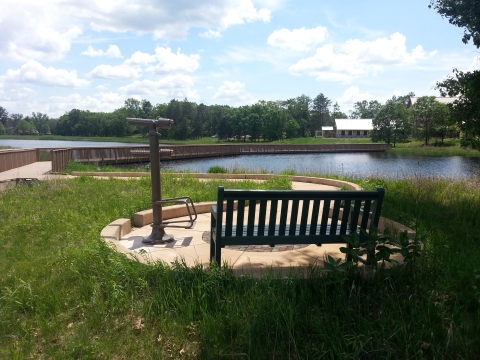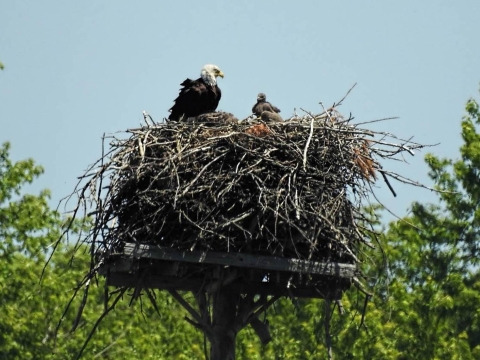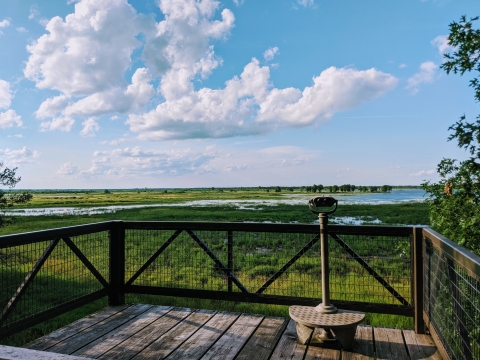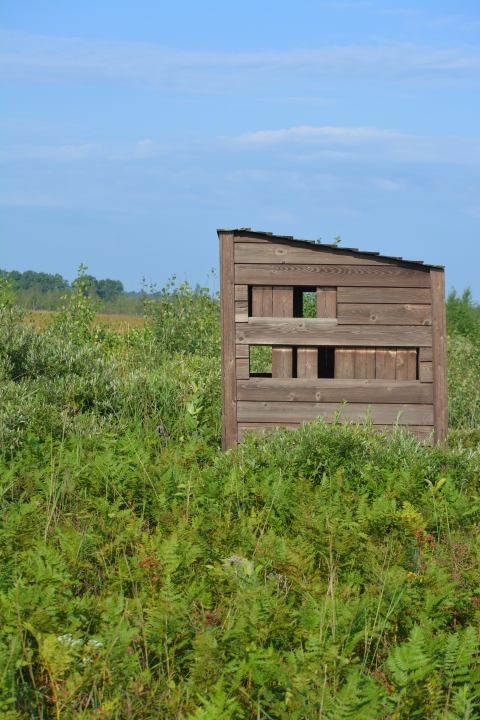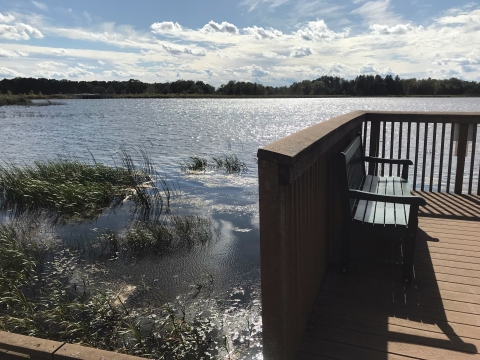Visit Us
National wildlife refuges offer us all a chance to unplug from the stresses of daily life and reconnect with our natural surroundings. Step into nature on one of six hiking trails that wind through the refuge’s unique landscapes that offer the chance to see both endangered and common species in a peaceful and serine area.
Unsure about where to go or what to do? Stop in the visitor center to find out more! The visitor center is a must see first stop for the most current things to do and hands on exhibits that engage all ages to learn about the hidden world nature holds.
Knowledgeable staff and volunteers that treasure this amazing place are always excited to share places to go and things to see on the refuge. They are always eager to hear how your visit is going!
Adventure awaits novices to outdoor enthusiasts with year-round activities. Experience the refuge by hiking, snowshoeing, ungroomed cross-country skiing, hunting, fishing, photography, nature and wildlife viewing as well as guided naturalist programs.
Driving Directions
The refuge entrance is located off of Hwy 21, four miles west of Necedah, Wisconsin or 18 miles east of Tomah, Wisconsin. To reach the visitor center, turn onto Headquarters Road and travel two miles north into the interior of the refuge.
Navigation Note: There are many township roads that crisscross the 40,000 acres of refuge, not all are passable. This sometimes confuses navigation apps. The visitor center is located at N11385 Headquarters Road, Necedah, Wisconsin 54646. Please be sure you are routed from Hwy 21 onto Headquarters Road. Many local seasonal roads are dead ends.
The refuge is located 150 miles from Milwaukee, Wisconsin and 180 miles from Minneapolis, Minnesota. Most of the refuge lies north of Highway 21 and west of Highway 80, with all property in Juneau County.
Fees
There is no charge to visit.
Restrooms
There are two sets of restrooms on the refuge attached to the visitor center. Indoor restrooms are available in the visitor center when open. Afterhours restrooms are attached to the west end of the visitor center and are open sunrise to sunset year round.
To find the afterhours bathrooms, head towards the visitor center from the parking lot, walk past the kiosk on the left-hand side of the center and follow the sidewalks, just a few steps, to the end of the building. Exterior doors have restroom markers on them and there is a seasonal water fountain.
Points of Interest
Visitor Center
The visitor center holds hands-on, minds-on interactive exhibits and activities for all ages and a six-minute refuge video about the seasons and wildlife of the refuge. Staff and volunteers are on hand to answer questions, point you in the right direction and love to hear about your plans, visit and wildlife sightings! Plan to stop in the Karner Korner, while in the visitor center, for a memento, nature guidebook, local art or new refuge wear! Don’t forget to step outside and check out the patios, boardwalks and trails to spend a few moments in nature. Center and trails are all family friendly and ADA accessible.
Ducks Unlimited Overlook
Along Headquarters Road this observation deck immerses visitors in an active wetland complex. The deck includes a donated spotting scope to view the area and especially the eagle nest across the wetland. Waterfowl and wading birds await visitors starting in March and are active into November. Raptors and mammals like wolves, coyote, beavers and otters are also frequent visitors year round.
Observation Tower
A two-story tower built by the Civilian Conservation Corps gives visitors a bird’s eye view to a back bay area of Rynearson Pool 1. The ground level of the tower has been updated to a cement pad with benches for visitors that would prefer not to climb to the top. Early birds can experience life on the wetland wake up and take off during spring and fall migrations. Be sure to stay a while! Visitors at all times of the year marvel at how natures reveals itself if you look and listen for more than 20 minutes. Black bears, deer, coyote, mink and weasels have all been spotted around the tower and trail.
Boghaunter Overlook
The center of Boghaunter Trail’s parking loop holds a slightly elevated deck. Don’t let its seemingly small stature fool you! Just a couple feet of elevation change reveal an intriguing landscape that is a mosaic of wetlands, sedge meadows, prairies and shrub edges bursting with life. If you adventure further along the Baordwalk Loop there is a photo blind and high sand ridge the trail traverses that also holds breathtaking views.
Photo Blinds
Wooden, year round photo blinds are located on Lupine Loop and Boghaunter Trail. Large enough for two people and two tripods. Bring your chair or stool, speed stick or tripod! The blind design has two heights of openings with sliding wooden panels to choose your set up. Upon entering, double check for wildlife, that call the refuge home, did not arrive before you! When done we appreciate the help to be sure to latch the door to prevent the wind from pulling it off the hinges!
Harvey’s Pond
Once a borrow pit for road construction, this little pond has been reclaimed by nature! Visitors can fish, hike, or simply sit and enjoy a little area of the refuge that has seemed to jump out of a fairy tale. Tall rushes and summer lily pads create a tranquil pocket away from everyday life. Trumpeter swans enjoy nesting and swimming here. River otters are also a common sight eating fish atop the beaver den. Sitting on the dock and watching the dragonflies hatch is also an amazing way to spend part of a day.
Benches and Tables
Visitors can find the occasional Aldo Leopold-styled bench placed around the trails. Recycled resin benches are found around the visitor center and its trail. Outdoor tables are placed near the visitor center, Lily Pad Outdoor Classroom and Harvey’s pond for educational groups. When not in use by naturalists, the public is welcome to use them. We ask that after use visitors leave it cleaner than they found it - pay it forward to wildlife and future visitors! Thank you!
Outdoor Amphitheaters and Tracking Pad
The refuge and Friends of Necedah National Wildlife Refuge are slowly adding elements into a natural play space and discovery area near the visitor center. Two outdoor amphitheaters and a bear paw tracking pad are available for visitors to explore. The amphitheaters are great for birdwatching, story time and watching wildlife. The bear paw has a sandy area that usually has real animal tracks left in it, can be used like a sandbox and if excavated in spots has real animal tracks imprinted in the base!
Goose and Sprague Pools
Slowly drive between these two impounded wetlands for waterfowl and wildlife viewing. Bring your camera and even stop and stay a while on the floating fishing and viewing platform. Listen for loons, whooping cranes, sandhill cranes, trumpeter swans and more.
Wildlife Drive
Many people ask about an auto tour or a wildlife loop. While no marked route exists, we can offer numerous township roads that cross the refuge to view wildlife from your car. Please call ahead to the visitor center for current road conditions and routes, as many township roads are seasonal or under construction. Call 608-565-2551 for the latest information.
What To Do
If you have 15 minutes
- Viewing Deck: Stop and stretch your legs at the Ducks Unlimited wetland complex along Headquarters Road. There is parking, an interpretive kiosk, viewing platform, viewing scope and information about the refuge for your next visit.
If you have one hour
- Visitor Center: Make the visitor center your first stop! Beyond the beautiful and clean bathrooms there are engaging hands-on exhibits, friendly staff and volunteers, updates about current happenings, a welcome video and expansive views of Rynearson Pool 1. Wildlife frequent the center grounds including whooping cranes and Karner blue butterflies can be seen from the center.
- Visitor Center Trails: The indoor and outdoor facilities are family-friendly, and ADA constructed. Enjoy sitting on the patio or taking a short walk on Muskrat Loop’s boardwalk. There are also native plantings, rain gardens and a short hike to the Lily Pad Classroom where you can connect to the longer trail and boardwalk or simply sit at the butterfly garden.
If you have half a day or more
- Visitor Center: Swing by the visitor center for current conditions and information.
- Hiking Trails: Hit the trails! Bring a water bottle and a snack or lunch. Boghaunter Trail System offers three loops of breathtaking landscapes teeming with birds, butterflies and four-legged wildlife. All three trails total over five miles. In contrast to our longest trail, you can pick from a few of the shorter trails and hit the prairie to the forest for a diverse range of sights, smells and wildlife encounters. Trails are open in the winter too! Grab your boots, snowshoes or cross-county skies.
- Drive the Backroads: Car rides along the township roads also offer plentiful wildlife viewing opportunities and a way to slowly travel through the ancient glacial lakebed. Plan to spend some time along the Goose and Sprague dike watching for birds before checking out the old oaks at the Lupine Loop parking area.
- Phenology and Wildlife Programs: Check out seasonal programs and naturalist guided activities.
- Go for a Paddle: Kayak or canoe on Suk Cerney Flowage to see the wonders of wetland tucked away and out of sight.
- Fish On! Take a kid fishing at Harvey’s Pond, which is open year round, or Goose Pool, which is open June 1 through September 15 and December 15 through March 15.
If you have more than a day
- Specialty Programs: Participate in our summer youth day camps.
- Hike EVERY trail
- Early Bird or Night Owl? Visit an observation deck or tower at sunrise and sunset.
- Hunt: Check out hunting seasons for turkey, grouse, white-tailed deer and more.
- Special Events: Participate in special spring birding events or celebrate National Wildlife Refuge week in October with us.
Know Before You Go
- Check the weather forecast. Weather can change quickly and become severe at our location. Visitor center staff and volunteers help keep an eye on the sky, forecasts, weather alerts and can help you look up the hourly forecast if needed.
- Bring water every time. Cool spring days can have a steady wind that wicks away moisture as the day gets warm. You can still become overheated and dehydrated in any season!
- Dress in layers. Frosty mornings give way to warm afternoons. Naturalists have been known to need stocking caps and gloves on May mornings only to be in summer uniforms by early afternoon.
- Share your plan. Tell someone else where and when you plan to be on the refuge. Cell coverage is not great across the refuge. It has also been told that when turned around and darkness falls every tree looks the same.
- Check current township road conditions with the visitor center. Seasonality, road repairs and weather can all quickly change public road conditions on the refuge. We have alternate routes for visitors when this happens! Map included!
- Call ahead! Occasionally a program could be canceled, or an amenity might not be available. We could also have a large group using a specific area. We can help you plan ahead! Give us a call at 608-565-2551 or email Necedah@fws.gov
Remember to bring
- A backpack is always handy!
- Dress in layers, a light wind break layer is also helpful
- Water bottle - and one for your leashed companion
- Bug spray or head net, as well as long sleeves and pants
- Sunscreen
- Comfortable sturdy shoes or boots
- A brimmed hat, and maybe even a stocking cap
- Snack for long days - no food or beverages are for sale at the visitor center
- Hobby items - binoculars, nature guides or apps, camera, kayak, hiking poles
- Refuge map or printed aerial photos from home
- Phone, GPS or compass
Forget something? We can help
Visitor Center Check Out Items: Free to use and available between 9:00 a.m. and 3:30 p.m.
- Binoculars
- Field Guides
- Scavenger Hunts
- Activity Backpacks and Jr. Ranger Programs
- Snowshoes - 3 or more inches of snow needed
Visitor Tips
Necedah National Wildlife Refuge has one of the largest savanna restorations taking place in Wisconsin. These efforts have provided habitat for more than 110 species of migratory birds, three species of amphibians, 14 types of reptiles and more than 44 species of butterflies in central Wisconsin. The restorations on the refuge are invaluable to the continued survival of many of these species, such as the state threatened Blanding’s turtle, the federally endangered Karner blue butterfly and whooping crane. They also are home to red-headed woodpeckers, golden-winged warblers and bobolinks. Savanna restorations, edged by prairie, wetland and barrens restoration work have created a mosaic of interconnected habitat across the refuge. What will you see exploring them?
General Tips
- Dawn and dusk are the best times to see wildlife
- There is a wildlife sightings board at the visitor center
- Your vehicle is a great observation blind - drive slowly, windows down and stay seated
Welcome to the Nursery!
Each summer the refuge provides a home for wildlife to raise their young. When you visit, here is how to be courteous in their home:
- Keep your distance! Usually a football field length of distance. We don’t want to add stress or fear or make them flee.
- Small groups create less disturbance! You might see more wildlife the fewer people you plod around with.
- Keep your movements soft and slow. Quick movements and sudden loud unnatural noises will startle and are stressful to watchful wild parents.
- People food is for people. The refuge provides ample buffets to wild parents feeding their young. Pack out everything you pack in! Wrappers and leftovers are not wildlife food.
- Keep your hands to yourself! We love wildlife…from a distance! If you see a sick, abandoned or injured animal, please call 608-565-2551. Please leave it in the area you found it.
Activities
The refuge has a wide variety of activities for people of all ages, skills, abilities and outdoor interests. Many activities peak by season, but opportunities to get outdoors and experience nature are available year round. Hiking, photography, bird watching, wildlife watching, environmental education and ranger lead activities all offer new memories each season.
Trails
Boghaunter Trail
Open Season: Year round for hiking or snowshoeing
Trail Section and Length: Meadow Beauty Loop - 0.8 mile
Trail Section and Length: Boardwalk Loop - 1.75 miles
Trail Section and Length: Tamarack Loop - 3.6 miles
Location of trail: West of Rynearson Pool 2
Surface: Boardwalk, gravel, mowed grass
Difficulty: Moderate to difficult
Information: Looking for an adventure? Boghaunter Trail System offers the longest trails on the refuge with a combined total of more than six miles of trails to explore. Trail loops wind through the different habitats of the refuge while showcasing the refuge’s amazing species diversity. The trail is named for the endangered ringed-boghaunter dragonfly occasionally found here. Hikers should expect to find something of interest on at least one of these trails! Combined, Meadow Beauty and Boardwalk Loop are more than two and a half miles long. The Tamarack Loop stretches more than three and a half miles and offers a slightly more challenging trail with some hills and forest in addition to wetland and prairie vistas. Watch for aerial wildlife such as dragonflies and damselflies or for larger mammals such as deer, bear, wolves and bobcat.
Birding Highlights: Sora, American bittern, whooping crane, king bird, Eastern bluebird and yellow-billed cuckoo
Harvey’s Pond Trail
Open Season: Year round for hiking or snowshoeing
Length: 0.7 mile
Location of trail: North of Hwy 21
Surface: Mowed grass
Difficulty: Moderate
Information: Harvey’s Pond Trail is less than a mile of mowed trail that winds between marshy lowlands and forested upland habitats. Whether it’s from the bank of the pond or the pier, fishing Harvey’s Pond is a great way to enjoy the refuge. Species you may encounter can include northern pike, largemouth bass, pumpkinseed, bluegill, yellow perch, crappie and brown bullhead. Although small in size, Harvey’s Pond is huge when it comes to its abundance of wildlife. Look for beavers, river otters and aquatic insects which may include both damselfly and dragonfly larvae. Harvey’s Pond offers a wonderful opportunity to discover the diversity that makes Necedah National Wildlife Refuge special during any time of the year.
Birding Highlights: Trumpeter swan, blue-wing teal, red-eyed vireo, ruby-crowned kinglet, pied-billed grebe, belted kingfisher and green heron.
Lupine Loop
Open Season: Year round for hiking or snowshoeing
Length: 0.8 mile
Location of trail: North of Goose and Sprague Pools
Surface: Gravel and mowed grass
Difficulty: Moderate
Information: Are you in search of the endangered Karner blue butterfly? Hike Lupine Loop in late May and late July to watch for this dimed-size beauty! The remainder of the year, this trail offers dynamic views of the backwater areas of Goose Pool. Be sure to check out the photo blind nestled along the shore line to look for both birds and other wildlife. Who knows what you will find!
Birding Highlights: Whooping crane, sandhill crane, trumpeter swan, ruddy duck, greater yellow legs, great blue heron, common loon, northern harrier, brown thrasher, American redstart and ovenbird.
Observation Tower Trail
Open Season: Year round for hiking or snowshoeing
Length: 1.0 mile
Location of trail: North of Grand Dike Road (20th Street)
Surface: Gravel, mowed grass
Difficulty: Moderate
Information: The Observation Tower Trail is a mile-long trail that winds through the refuge’s forested habitats adjacent to the shore of Rynearson Pool 1. This trail offers a two-story observation tower with a viewing scope north of the parking lot, as well as a small viewing blind at the far-east end. Sunrise at the tower offers amazing and unique sights and sounds. Spend some time here and watch as wading birds emerge from grasses and sedges. Ducks and other waterfowl love dabbling in the shallow waters of the pool and loafing on the white sandbars during the summer months. Along the trail be on the lookout for distinct black bear tracks, eye-catching scarlet tanagers and badger burrows! The viewing blind offers cover for viewing and photographing wildlife in the backwater areas of the pool.
Birding Highlights: Whooping crane, sandhill crane, trumpeter swan, tundra swans during migration, great egret during migration, northern shoveler, northern pintail, bald eagle, common yellowthroat, yellow warbler, blue-gray gnatcatcher, black and white warbler and scarlet tanager.
Visitor Center Trail
Open Season: Year round for hiking or snowshoeing
Length: Muskrat Loop - 0.25 mile
Length: Karner Loop - 0.75 mile
Location of trail: Visitor Center
Surface: Asphalt, boardwalk, gravel (ADA)
Difficulty: Easy, multiple stops and benches
Information: Muskrat Loop takes 10 minutes to stroll around. Stop at the viewing scopes to scan the wetland for whooping cranes and trumpeter swans. Looking for more? Hike the Karner Loop which winds through forest and savanna and then step onto the boardwalk along with Rynearson Pool 2. The visitor center has outdoor bathrooms that are open from dawn to dusk on the west side of the building.
Birding Highlights: Whooping crane, sandhill crane, trumpeter swan, tundra swans during migration, great egret during migration, red-headed woodpecker, golden-winged warbler, ruby-throated hummingbird, cedar waxwing, sharp-shinned hawk and wood thrush.
White-Tail Loop
Open Season: Year round for hiking or cross-country skiing
Length: 1.7 miles
Location of trail: South of Grand Dike Road, park at the split rail fence
Surface: Mowed grass
Difficulty: Moderate
Information: If you are looking for a leisurely stroll through the woods, White-Tail Loop is definitely your style! Explore one of the refuge’s older forests and the wildlife that inhabits it. Watch for spring peepers at your feet and birds in the canopy, as you take in a quiet peek of the upland forested areas of the refuge. This dynamic trail offers opportunities for both serenity and exciting wildlife photography!
Birding Highlights: Barred owl, eastern wood-pewee, Baltimore oriole, indigo bunting, black-billed cuckoo, pileated woodpecker, brown creeper, and white-breasted nuthatches.
Related Documents
Hunting, Fishing and Trapping Brochure and Map
Rules and Policies
Necedah National Wildlife Refuge is an area set aside and managed for wildlife. To avoid or reduce disturbance during critical times of the year public recreation is focused in certain areas. Wildlife viewing is encouraged year round at the visitor center and on the hiking trails or township roads. All other refuge areas have specific dates for listed recreational opportunities that are open to foot travel.
Know the unique rules of each refuge before you visit. Different locations have sensitive flora, fauna and various wildlife needs that can change by season. Be aware and follow these rules to ensure continuous public enjoyment of the refuge.
Locations
Driving Directions
The refuge entrance is located off of Hwy 21, four miles west of Necedah, Wisconsin or 18 miles east of Tomah, Wisconsin. To reach the visitor center, turn onto Headquarters Road and travel two miles north into the interior of the refuge.
Navigation Note: There are many township roads that crisscross the 40,000 acres of refuge, not all are passable. This sometimes confuses navigation apps. The visitor center is located at N11385 Headquarters Road, Necedah, Wisconsin 54646. Please be sure you are routed from Hwy 21 onto Headquarters Road. Many local seasonal roads are dead ends.
The refuge is located 150 miles from Milwaukee, Wisconsin and 180 miles from Minneapolis, Minnesota. Most of the refuge lies north of Highway 21 and west of Highway 80, with all property in Juneau County.

